RL.4 Lesson Plans
CCSS.ELA-LITERACY.RL.4
:"Literature"
These lesson plans can help students practice this Common Core State Standards skill.
Lesson Plans
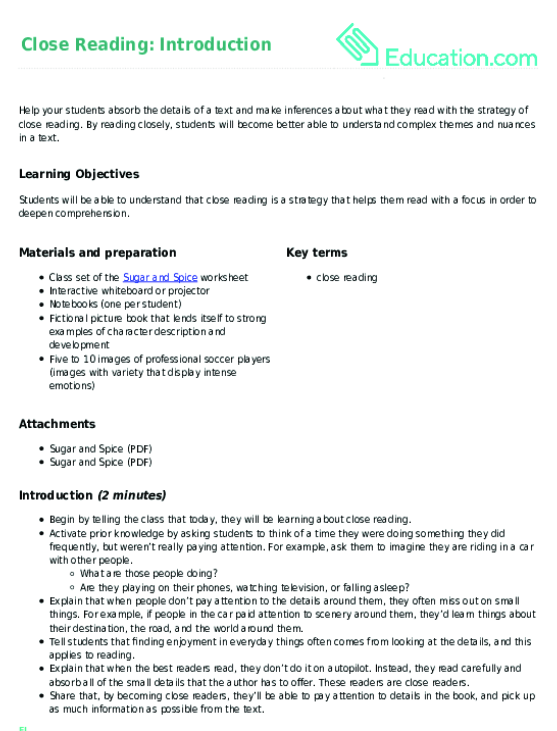
Close Reading: Introduction
Lesson plan
Close Reading: Introduction
Help your students absorb the details of a text and make inferences about what they read with the strategy of close reading. By reading closely, students will become better able to understand complex themes and nuances in a text.
Lesson plan

Papering the Plains States
Lesson plan
Papering the Plains States
Making inferences from texts about the Plains States, your students will learn how to read with a purpose! In this lesson, your students will practice important skills while developing knowledge of various states.
Lesson plan

Close Reading Through Word Choice
Lesson plan
Close Reading Through Word Choice
Every great reader and writer knows that syntax matters. During this lesson, students will use the close reading strategy to focus on word choice, and use their understanding of syntax to develop theories about patterns in the text.
4th Grade
Lesson plan

Writing: Show, Don’t Tell
Lesson plan
Writing: Show, Don’t Tell
Help students learn about descriptive writing with this engaging lesson. Your class will learn to show character emotions though the “show, don’t tell” writing technique with videos, practice writing, and class participation.
3rd Grade
Lesson plan
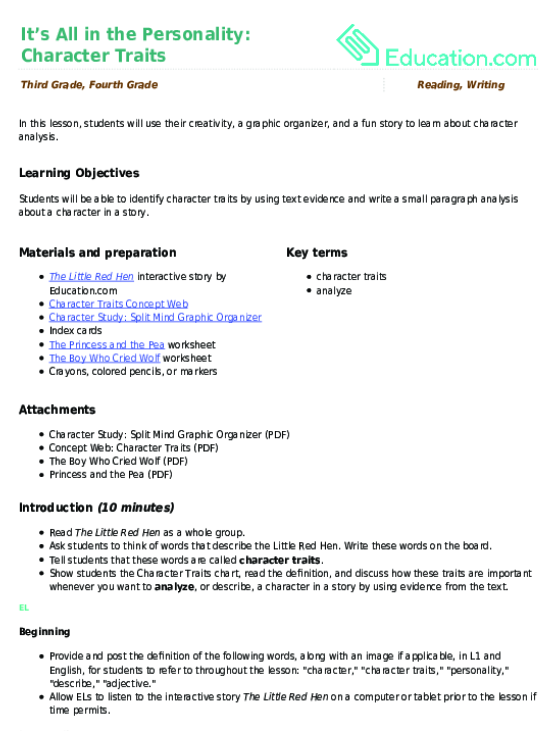
It’s All in the Personality: Character Traits
Lesson plan
It’s All in the Personality: Character Traits
In this lesson, students will use their creativity, a graphic organizer, and a fun story to learn about character analysis.
3rd Grade
Lesson plan
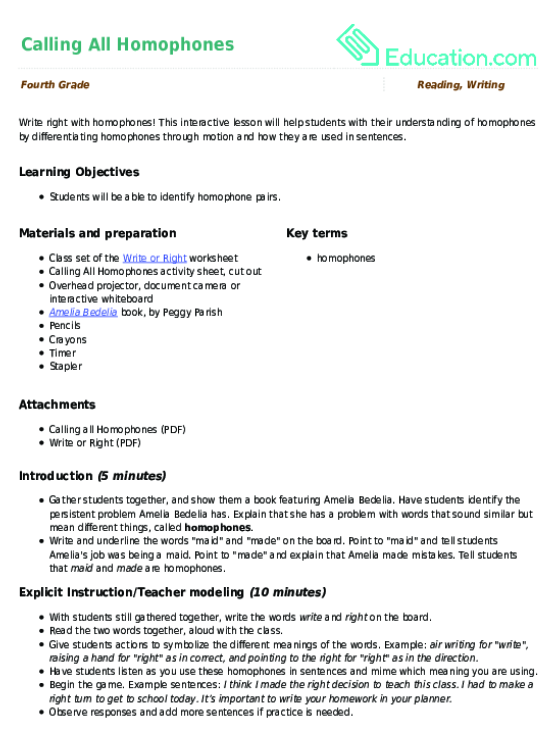
Calling All Homophones
Lesson plan
Calling All Homophones
Write right with homophones! This interactive lesson will help students with their understanding of homophones by differentiating homophones through motion and how they are used in sentences.
4th Grade
Lesson plan

Sum It Up: Introduction to Writing Summaries
Lesson plan
Sum It Up: Introduction to Writing Summaries
Students are often taught that written pieces should be long and detailed, but this isn't the case when it comes to summaries. This lesson gives students the chance to practice keeping summaries concise in a fun and engaging way.
4th Grade
Lesson plan
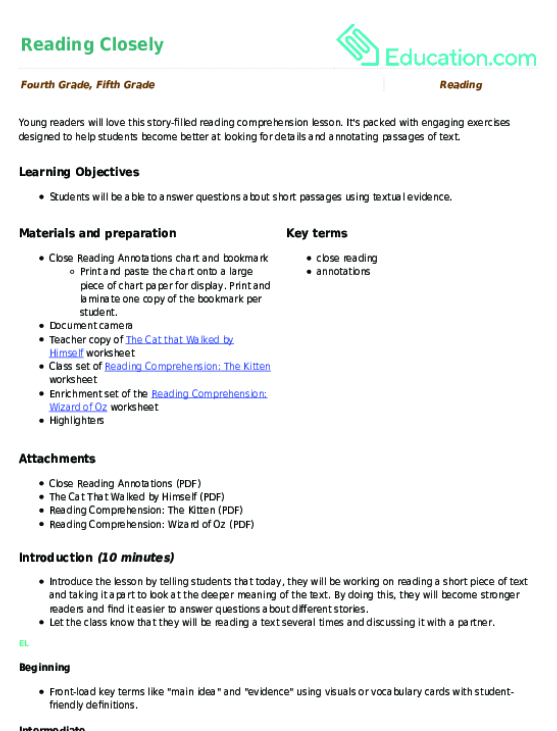
Reading Closely
Lesson plan
Reading Closely
Young readers will love this story-filled reading comprehension lesson. It's packed with engaging exercises designed to help students become better at looking for details and annotating passages of text.
4th Grade
Lesson plan

Día de los Muertos: Traditions in History
Lesson plan
Día de los Muertos: Traditions in History
Sugar skulls and fancy dress aren't all there is to the Day of the Dead. In this lesson students will learn about several societies that celebrate their dead, as well as some of the history behind the traditions of the Día de los Muertos.
4th Grade
Lesson plan

Pumpkin Creatures
Lesson plan
Pumpkin Creatures
This lesson plan integrates art and reading to create a character by personifying a pumpkin. Your students will enjoy writing a story about a character that they have created!
3rd Grade
Lesson plan

Traditional Literature: Story Mapping
Lesson plan
Traditional Literature: Story Mapping
Students will learn how to identify story elements and create a short and sweet summary. They will fill out a graphic organizer and solidify their understanding by creating illustrations to show major plot points that they find themselves!
2nd Grade
Lesson plan

Close Reading: Reading Through Character Emotion
Lesson plan
Close Reading: Reading Through Character Emotion
Close reading isn’t about just ticking through words on a page; it’s about absorbing ideas and expanding on them. In this lesson, students will use this strategy to make interpretations about a character's emotions through their actions.
Lesson plan

Fiction vs. Nonfiction
Lesson plan
Fiction vs. Nonfiction
Kids will love learning some fun facts about elephants while developing their reading comprehension skills. Using T-charts and Venn diagrams, they'll analyze stories and explore different characteristics of fiction and nonfiction.
4th Grade
Lesson plan

Venn Diagram Collage
Lesson plan
Venn Diagram Collage
Arts and crafts, Venn diagrams, and literature all come together as students compare and contrast stories. Opportunities for student creativity are endless!
Lesson plan
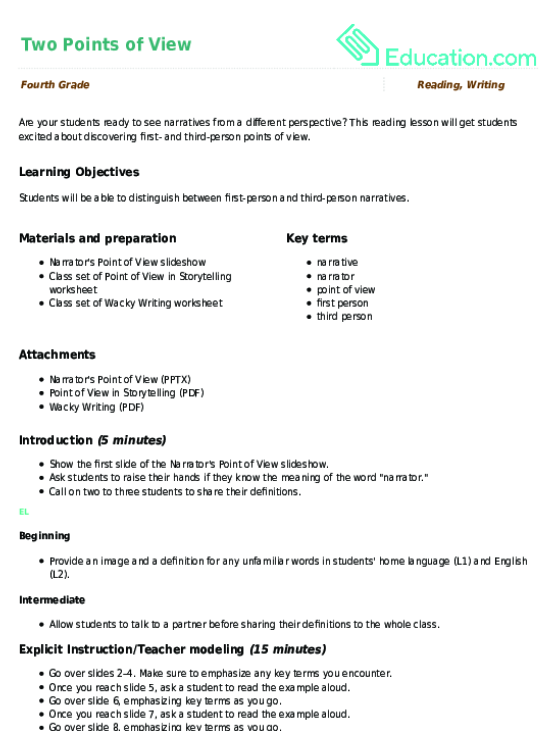
Two Points of View
Lesson plan
Two Points of View
Are your students ready to see narratives from a different perspective? This reading lesson will get students excited about discovering first- and third-person points of view.
4th Grade
Lesson plan

Author's Purpose: Easy as PIE
Lesson plan
Author's Purpose: Easy as PIE
Give your class the "write" tools they need to become excellent authors. In this literary lesson, students use their knowledge of author's purpose to successfully write pieces that persuade, inform, and entertain.
4th Grade
Lesson plan

Native American Legends
Lesson plan
Native American Legends
Social studies, reading comprehension, and writing come together in this high-engagement lesson about Native American legends!
4th Grade
Lesson plan

Who Said It?
Lesson plan
Who Said It?
Students will have a blast creating their own cartoons and comics. This lesson provides an engaging method to help students demonstrate the use of quotation marks when writing.
4th Grade
Lesson plan

Jazzy Bio Poems
Lesson plan
Jazzy Bio Poems
Integrate reading, writing, and social studies in this lesson about famous jazz musicians! This lesson would fit perfectly in a unit about biographies or Black History Month.
4th Grade
Lesson plan

Myths and Man
Lesson plan
Myths and Man
Popular fiction throughout the ages colors the way people speak. In this short lesson, students will read a myth and non-fiction paragraph in order to identify and define words that come from mythology.
4th Grade
Lesson plan

Poetry, Prose, and Drama, Oh My!
Lesson plan
Poetry, Prose, and Drama, Oh My!
Nourish your child's inner writer with this lesson on three different forms of literature: poetry, prose, and drama. After going through some examples of each, students will demonstrate their knowledge by filling out bubble maps.
4th Grade
Lesson plan

What's For Breakfast?
Lesson plan
What's For Breakfast?
Teach your class to develop strong inferencing skills by focusing on clues and hard evidence. In this lesson, students will play a game of “What’s for Breakfast?” to help them link context clues with word meaning.
4th Grade
Lesson plan
Reading the Clues, Understanding Plot Lesson Part II
Lesson plan
Reading the Clues, Understanding Plot Lesson Part II
Have you ever wished that books, like movies, would state their conflict and genres on the cover? With the help of an Education.com workbook, students will learn to find the clues and read like a writer.
4th Grade
Lesson plan
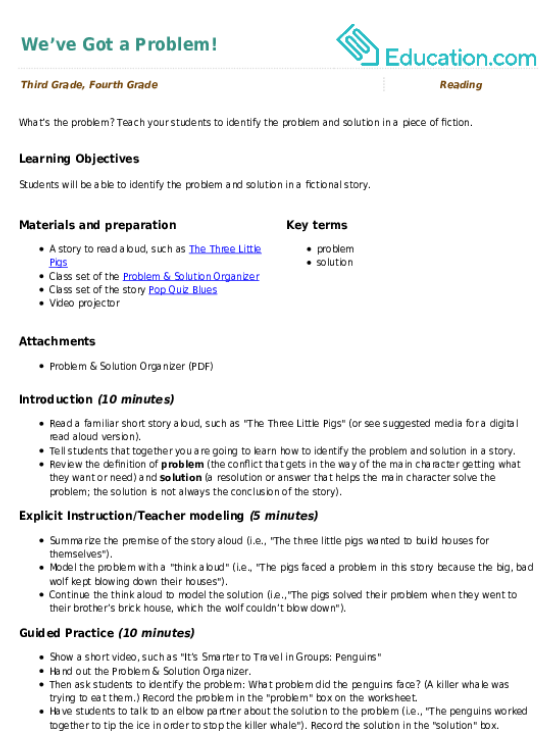
We’ve Got a Problem!
Lesson plan
We’ve Got a Problem!
What’s the problem? Teach your students to identify the problem and solution in a piece of fiction.
3rd Grade
Lesson plan

What's So Different? Comparing Characters
Lesson plan
What's So Different? Comparing Characters
Using your acting skills and a great book by Chris Van Allsburg, you will lead your students on an adventure to compare characters and events throughout a book.
4th Grade
Lesson plan
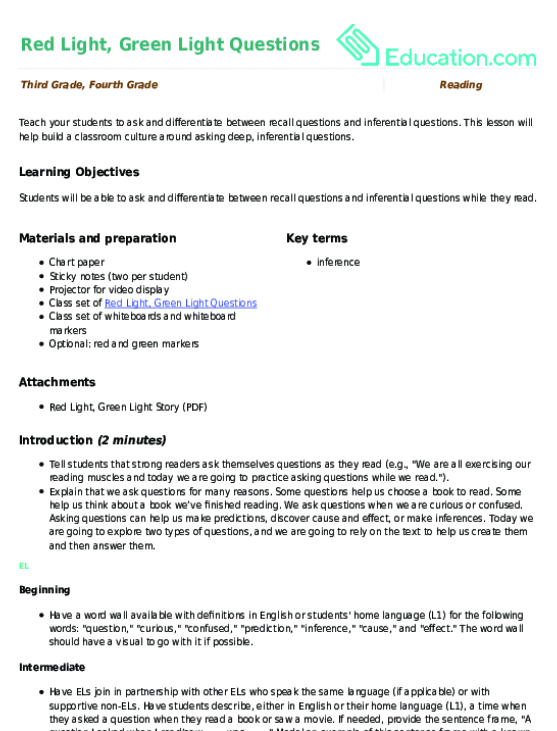
Red Light, Green Light Questions
Lesson plan
Red Light, Green Light Questions
Teach your students to ask and differentiate between recall questions and inferential questions. This lesson will help build a classroom culture around asking deep, inferential questions.
3rd Grade
Lesson plan

Elements of Poetry
Lesson plan
Elements of Poetry
Introduce your students to some of the major structural elements of poetry in this comprehensive lesson.
4th Grade
Lesson plan

Whose Point Is It Anyway?
Lesson plan
Whose Point Is It Anyway?
What if Cinderella’s stepsisters weren’t really evil? In this engaging lesson, you will introduce your students to multiple points of view and discuss how these different perspectives can change a reader’s experience.
4th Grade
Lesson plan

Character Actions and Emotions
Lesson plan
Character Actions and Emotions
Use this lesson to help your ELs describe a character’s emotion based on actions. It can be a stand-alone lesson or used as support to the lesson Close Reading: Reading Through Character Emotion.
4th Grade
Lesson plan

Comparing Literature Themes
Lesson plan
Comparing Literature Themes
Your ELs will compare and contrast two similar stories while strengthening their grammar skills related to noun and pronoun agreement in this lesson. Use it as a stand-alone lesson or as a precursor to the lesson Venn Diagram Collage.
4th Grade
Lesson plan


